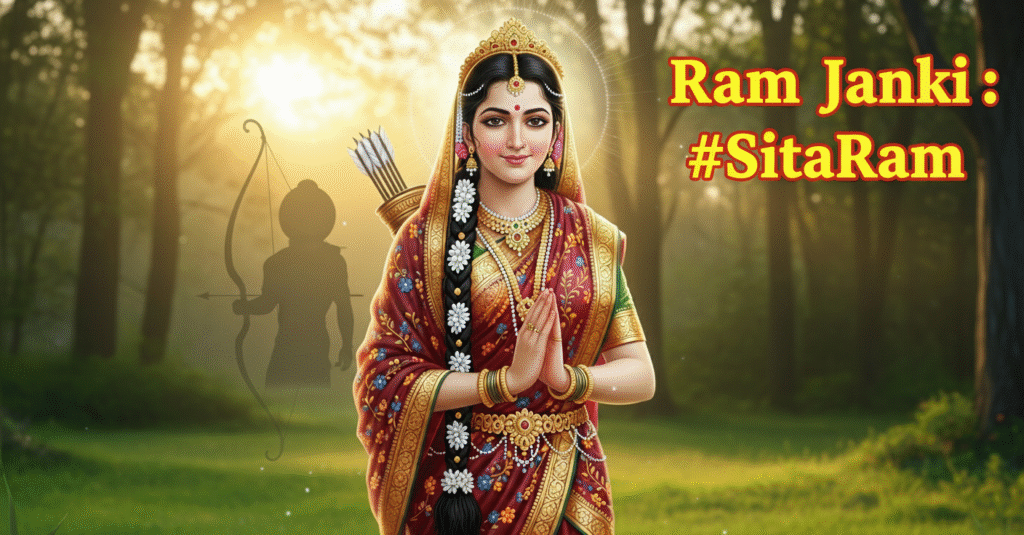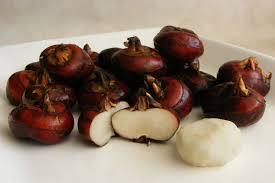“Like a lotus that blooms untainted in muddy waters, Mata Sita’s character radiates purity amidst the complexities of human existence, teaching us that true virtue transcends circumstance.”

In the sacred verses of Goswami Tulsidas’s Ramcharitmanas, composed between 1574-1577 CE, Mata Sita emerges not merely as a character in an epic narrative, but as a luminous embodiment of divine femininity and moral excellence. Tulsidas completed this monumental work on Vivaha Panchami, which commemorates the wedding day of Rama and Sita, perhaps symbolically crowning his masterpiece with the very essence of divine union that Sita represents.
The Ramcharitmanas, literally meaning “the lake of the deeds of Rama,” flows like a sacred river through the consciousness of millions, and within its pristine waters, Sita’s virtues shine like jewels catching the light of eternal truth. Her character serves as both mirror and lamp, reflecting our highest aspirations while illuminating the path toward spiritual refinement.
Born to King Janaka of Mithila, the philosopher-king who embodied the perfect balance of worldly wisdom and spiritual insight, Devi Sita was discovered in a furrow during a yajna, the divine daughter of Bhumi Devi, rooted in Earth yet destined to realign the celestial order. This earth-born nature becomes the cornerstone of her character: like the earth that bears all yet remains unperturbed, Sita embodies the paradox of infinite strength wrapped in infinite gentleness.
Her Swayamvar, centered around Lord Shiva’s divine bow, was not merely a royal ceremony but a cosmic threshold. While the mightiest kings faltered before the sacred weapon, Shri Ram lifted it with the effortless grace of one aligned with cosmic Dharma. In that moment, Devi Sita saw not just a partner but a soul forged in the same fire of righteousness. Their union transcended royal matrimony, it was the confluence of Dharma and Shakti, a sacred bond destined to reshape humanity’s moral landscape.
Yet from this celestial celebration, Mata Sita was thrust into trials that would break ordinary souls: forest exile, abduction by Ravana, the trial by fire, abandonment during pregnancy, and solitary motherhood in Valmiki’s ashram. Each ordeal she bore not with defeat but with divine defiance, her stillness thundering through time. As the document wisely notes: “Mata Sita is not the shadow of Ram’s greatness, she is the canvas upon which it is painted.”
The Sacred Constellation of Virtues
1. Purity (Pavitrata) and Chastity (Pativrata Dharma)
In Tulsidas’s masterwork, Sita’s purity transcends the physical realm, manifesting as spiritual transparency, a crystalline state of being that allows divine truth to shine through unrefracted. Her unwavering fidelity to Lord Rama becomes a living meditation, a constant remembrance that transforms every moment into sacred offering.
During her captivity in Lanka, surrounded by demons and faced with Ravana’s threats, her resolve never wavers. Tulsidas captures this unwavering commitment:
“Siya man Rama charan anuragi, taji sab aas Ram pag lagi.” “Sita’s heart is devoted to Rama’s feet, forsaking all desires and clinging solely to His divine presence.”
This verse reveals purity not as mere abstinence but as complete absorption—the soul’s natural gravitation toward its true home. Her ordeal in the Agnipariksha (trial by fire) becomes not just vindication but revelation: she emerges unscathed because fire recognizes its own essence of purity.
“Patihit kiye pavan apanau, Ram charan rati ati sukh paunau.” “For the sake of her lord, she purifies her being, finding supreme bliss in devotion to Rama’s feet.”
Here, Tulsidas unveils a profound truth: chastity becomes the alchemical process through which human love transmutes into divine realization.
2. Devotion (Bhakti) – The River That Knows Its Ocean
Sita’s devotion flows like an inexhaustible river that has found its ocean. In Tulsidas’s portrayal, her bhakti transcends the boundaries between human love and divine worship, creating a seamless tapestry where the personal becomes universal, the intimate becomes infinite.
In the Sundar Kand, while imprisoned in Ashok Vatika, her prayers become mantras of unwavering faith:
“Ram charan pankaj man dolai, Siya sukh sadan binavati bolai.” “Sita’s mind sways at the lotus feet of Rama, her words beseeching the abode of bliss.”
This devotion sustains her through the darkest hours, proving that true bhakti is not dependent on circumstances but creates its own sanctuary of peace. Even in despair, she chants:
“Ram nam japu din aru rati, Siya hiy Hari bina na bisrati.” “Chanting Rama’s name day and night, Sita’s heart never strays from the Lord.”
Like a compass needle that always points north regardless of the terrain it crosses, her devotion remains constant, offering us a template for maintaining spiritual direction amidst life’s turbulence.
3. Courage (Sahas) and Resilience – The Bamboo That Bends But Never Breaks
Sita’s courage manifests not as aggressive defiance but as dignified resistance—the bamboo that bends with the storm yet never breaks. Tulsidas presents her confrontations with Ravana as masterclasses in fearless truth-telling:
“Siya kaha Ravan san jayi, Ram bina mai mritak samayi.” “Sita declared to Ravana, ‘Without Rama, I am as good as dead.'”
This declaration reveals courage of the highest order—not the absence of fear but the presence of something greater than fear. Her strength flows from a source deeper than personal will:
“Bal tej Prabhu charan samip, Siya na darati Ravan pratap.” “With the strength and radiance of the Lord’s feet, Sita fears not Ravana’s might.”
Her resilience teaches us that true courage is not self-generated but sourced from our connection to principles larger than ourselves. Like a tree whose roots reach deep underground waters, her strength flows from the eternal wellspring of dharma.
4. Compassion (Karuna) and Humility – The Ocean That Gives to All Rivers
Even in her own suffering, Sita radiates compassion like the sun that shines equally on palace and hut. Tulsidas portrays her as a being whose personal pain never hardens into selfishness:
“Siya karuna sindhu sukh dai, sab jiv san sahaj suhai.” “Sita, an ocean of compassion, brings joy and naturally delights all beings.”
This compassion stems from profound humility—the recognition of interconnectedness that makes others’ suffering one’s own. Her interactions reveal a heart free from the ego’s tendency to hoard love:
“Deen dayal Siya man basai, sab san karati preeti na kasai.” “The merciful Sita dwells in a heart free of malice, showing love to all without distinction.”
Her humility teaches us that true greatness lies not in elevating oneself above others but in recognizing the divine spark in all beings, creating bridges where others see barriers.
5. Sacrifice (Tyaga) – The Fragrance That Spreads by Giving Itself Away
Sita’s sacrifices throughout the Ramcharitmanas read like a symphony of selfless love, each movement revealing new depths of meaning. From choosing forest exile over palace comfort to enduring separation for the sake of dharma, her life becomes a continuous offering at the altar of righteousness.
Her sacrifices are not desperate gestures of someone with no choice but conscious decisions of one who understands that some things are worth more than personal comfort. Like sandalwood that releases its fragrance even when cut, her sacrifices spread the sweet scent of virtue across generations.
6. Wisdom (Prajna) and Discernment
Sita’s wisdom manifests not in scholarly discourse but in the practical art of living dharma under extreme circumstances. She navigates the complexities of duty, desire, and destiny with the skill of a master mariner reading the stars.
Her responses to various challenges reveal a mind that has integrated spiritual truth with practical intelligence, showing us that wisdom is not abstract knowledge but the ability to choose correctly when the stakes are highest.
7. Forgiveness (Kshama) – The Alchemy That Transforms Poison into Nectar
Perhaps most remarkably, Sita maintains a heart free from bitterness despite enduring injustices that would embitter most souls. Her forgiveness becomes a creative force, transforming the poison of resentment into the nectar of understanding.
This forgiveness is not weakness but strength, the refusal to allow external circumstances to corrupt the inner sanctuary of peace. Like the earth that continues to provide for those who wound it, her forgiveness becomes a source of healing for the very world that has hurt her.
Lessons for Our Fractured Age
In our contemporary world, gasping under the weight of polarization, gender conflict, and moral confusion, Mata Sita offers profound civilizational correctives:
Gender Justice & Empowerment: True strength, she demonstrates, lies in dignity rather than defiance, in courage rather than aggression. Her model of empowerment is not the diminishment of others but the elevation of all through virtue.
Ethics in Public Life: Her unwavering commitment to truth over convenience serves as a mirror to politics, judiciary, and media alike. In an age of expedient compromises, she reminds us that integrity is not negotiable.
Mental Health & Spiritual Strength: She teaches that resilience is not repression but the sacred art of surviving with grace—maintaining inner equilibrium while facing external chaos.
Ecological Consciousness: Her earth-born nature and final return to Mother Earth represents the ultimate call for sustainable, sacred living, reminding us that we are not separate from nature but expressions of it.
Family & Social Harmony: Her life underscores the delicate interdependence between individual fulfillment and social responsibility, a balance desperately needed in our hyper-individualistic age.
The Eternal Mandate
Let us be clear: Mata Sita is not a passive heroine waiting for rescue. She is a conscious moral force—a woman of unimaginable strength, clarity, and compassion. In Ramcharitmanas, she stands as the heart of the epic’s ethical universe, proving that virtue is not weakness but the highest form of power.
Her story teaches us that true empowerment comes not from external validation but from internal alignment with dharma. Like a river that carves canyons through persistent flow rather than violent force, she shows us how gentle persistence can reshape the hardest hearts and highest obstacles.
In Tulsidas’s vision, Sita’s virtues are not museum pieces to be admired from afar but living qualities to be cultivated and embodied. She offers us a template for integrated living, showing how to be simultaneously rooted and flexible, strong and gentle, individual and universal.
Mata Sita is not a memory; she is a mandate. She is not the past—she is the possibility of our future.
Her luminous character continues to serve as both mirror and lamp: reflecting our highest aspirations while illuminating the path toward their realization. In her story, we find not just inspiration but instruction, not just beauty but blueprint for building a more dharmic world.
Like the lotus that offers its fragrance to all who approach regardless of their worthiness, Mata Sita’s character in Ramcharitmanas continues to emanate the sweet perfume of divine virtue, inviting each of us to discover the same radiant qualities within ourselves. Her mirror shows us not only what we might become but what, in our deepest essence, we already are; children of the same divine source that expressed itself so perfectly through her extraordinary life.


